Enhancing Multiple-Access Capacity and Synchronization in Satellite Beam Hopping with NOMA-SIC
Abstract
1. Introduction
- We propose an enhanced NOMA-SIC multiple access framework for the satellite beam-hopping context, which addresses the capacity limitations of traditional MF-TDMA.
- We derive closed-form theoretical expressions for the BER of SIC reception, which fills a critical gap in the performance analysis for multi-signal satellite systems.
- We design a novel carrier synchronization scheme that combines a preset frequency offset with bi-directional adaptive iteration, which solves the challenge of robust synchronization under low SNR and strong interference.
- We optimize a high-efficiency dual unique word (UW) burst frame structure that complements our synchronization scheme, which significantly reduces overhead and increases transmission efficiency to 97%.
2. System Model and Theoretical Analysis
2.1. Principle of SIC
2.2. Theoretical Performance Analysis for Two Overlapping Signals
- : amplitude of the user signal;
- : transmitted BPSK signal, taking values in ±1;
- : AWGN with power spectral density .
- : stronger signal;
- : weaker signal.
- : Probability that the first signal transmitted symbol is 1, which is 1/2.
- : Probability that the first signal transmitted symbol is −1, which is 1/2.
- : Probability that the second signal transmitted symbol is 1, which is 1/2.
- : Probability that the second signal transmitted symbol is −1, which is 1/2.
- : Probability that the first signal , when transmitted as 1, is incorrectly detected as −1.
- : Probability that the first signal , when transmitted as -1, is incorrectly detected as 1.
- : Probability that the first signal , when transmitted as 1 and the second signal as 1, is incorrectly detected as −1.
- : Probability that the first signal , when transmitted as 1 and the second signal as -1, is incorrectly detected as -1.
- : Probability that the first signal , when transmitted as -1 and the second signal as 1, is incorrectly detected as 1.
- : Probability that the first signal , when transmitted as -1 and the second signal as -1, is incorrectly detected as 1.
- and are the transmitted symbols for the first and second signals, respectively.
- 1/−1 represents the detected symbol for the signal.
- SNR of the primary signal ();
- Amplitude ratio ;
- Real-time phase offset of the secondary signal φ1.
2.3. Theoretical Performance Analysis for Three Overlapping Signals
- SNR of the first signal;
- Amplitude ratio between the first and second signals
- Amplitude ratio between the first and third signals ;
- Instantaneous phase offset of the second signal φ1;
- Instantaneous phase offset of the third signal φ2.
3. Proposed Modeling
3.1. Carrier Synchronization Algorithmsfor Burst Signals
3.1.1. Common Carrier Synchronization Algorithms
- Multiplying the input sampled signal with two locally generated orthogonal carriers;
- Filtering and demodulating the resulting phase detection signal;
- Feeding the output to a phase detector to generate an error signal;
- Filtering this error through a loop filter to control a numerically controlled oscillator (NCO), which regenerates the local carrier;
- Forming a feedback loop by mixing the local carrier with the input signal again.
- Frequency-domain estimation, such as the method in [12], which detects coarse frequency by searching for spectral peaks and then refines using spectral features;
- Time-domain estimation, which extracts frequency offset from signal autocorrelation.
3.1.2. Carrier Synchronization for Dual-Signal SIC Reception
3.2. Capacity Enhancement via Pre-Frequency Offset and Dual-Parameter Iterative Carrier Synchronization
- Optimizing the SNR of the primary signal;
- Maintaining an appropriate power ratio between the primary and secondary signals;
- Ensuring uniform phase distribution at each sampling point for the secondary signal;
- Improving the efficiency of burst frame structure.
3.2.1. Dual-Parameter Iterative Carrier Synchronization
- Signal Buffering: The input signal is buffered using the time-slot synchronization signal in the beam-hopping communication system. A complete burst time-slot signal is stored.
- First Forward Carrier Synchronization: The process begins with the first forward synchronization using relatively wide loop parameters. Specifically, the PLL parameters C1 and C2 are calculated. The data is sequentially read from the buffer, and the PLL is used for forward carrier synchronization until the entire burst frame is processed. During this process, the frequency estimate is stored, along with the final phase value of the PLL’s Numerically Controlled Oscillator (NCO). The carrier-synchronized data is then cached.
- First Reverse Carrier Synchronization: Next, the first reverse carrier synchronization is performed with narrower loop parameters, calculated as C3 and C4. The frequency estimate from the first forward synchronization is averaged, with the latter half of the data selected for averaging (typically more than 100 symbols, depending on burst time). The loop frequency control word is inverted and the NCO phase is initialized to the last tracked phase value from the first forward synchronization. The data is then read in reverse from the buffer and the PLL is applied for reverse carrier synchronization. The NCO’s final output phase is stored, and the reverse-synchronized data is cached.
- Second Forward Carrier Synchronization: The second forward carrier synchronization is performed using a narrower loop bandwidth, with PLL parameters C3 and C4 derived from the reverse synchronization step. The frequency estimate from the first forward synchronization is averaged using the frequency value from the reverse pass . The NCO phase is initialized with the last tracked phase from the reverse synchronization. Data is then read in sequence from the buffer, and forward carrier synchronization is carried out. The synchronized data is stored.
| Algorithm 1: Bi-Directional Adaptive Synchronization |
| INPUT: raw_signal, beam_hopping_sync_signal OUTPUT: synced_signal //Step 1: Signal Buffering BEGIN burst_signal = BUFFER_SIGNAL(raw_signal, beam_hopping_sync_signal) INITIALIZE buffer WITH burst_signal L = LENGTH(burst_signal) //Step 2: First Forward Synchronization (Wide Bandwidth) SET PLL_PARAMS = {C1, C2}//Wide loop parameters INITIALIZE forward_pll WITH PLL_PARAMS INITIALIZE forward_phase_estimate [1..L] INITIALIZE forward_freq_estimate [1..L] INITIALIZE data_forward1[1..L] FOR i = 1 TO L DO symbol = READ_BUFFER(buffer, i) (synced_symbol, phase, freq) = forward_pll.PROCESS(symbol) data_forward1[i] = synced_symbol forward_phase_estimate[i] = phase forward_freq_estimate[i] = freq END FOR stored_freq_est1 = forward_freq_estimate[L] stored_phase_est1 = forward_phase_estimate[L] //Step 3: First Reverse Synchronization (Narrow Bandwidth) SET PLL_PARAMS = {C3, C4}//Narrow loop parameters INITIALIZE reverse_pll WITH PLL_PARAMS INITIALIZE reverse_phase_estimate [1..L] INITIALIZE data_reverse [1..L] //Average frequency estimate (last N symbols, N ≥ 100) avg_freq = MEAN(forward_freq_estimate[L-99:L]) reverse_pll.SET_FREQUENCY(-avg_freq)//Invert frequency control reverse_pll.SET_INITIAL_PHASE(stored_phase_est1) FOR i = L DOWNTO 1 DO symbol = READ_BUFFER(buffer, i) (synced_symbol, phase, freq) = reverse_pll.PROCESS(symbol) data_reverse[i] = synced_symbol reverse_phase_estimate[i] = phase END FOR stored_phase_est2 = reverse_phase_estimate [1] //Step 4: Second Forward Synchronization (Narrow Bandwidth) SET PLL_PARAMS = {C3, C4}//Narrow loop parameters INITIALIZE final_pll WITH PLL_PARAMS INITIALIZE synced_signal [1..L] final_pll.SET_INITIAL_PHASE(stored_phase_est2) final_freq = (avg_freq + reverse_pll.GET_FREQ_ESTIMATE())/2 final_pll.SET_FREQUENCY(final_freq) FOR i = 1 TO L DO symbol = READ_BUFFER(buffer, i) (synced_symbol, phase, freq) = final_pll.PROCESS(symbol) synced_signal[i] = synced_symbol END FOR RETURN synced_signal END ALGORITHM |
3.2.2. Optimized High-Efficiency Burst Frame and Capture Method
- Signal Buffering: Utilize the time-slot synchronization signal in the beam-hopping communication system to buffer the incoming signal, capturing a complete burst time-slot signal.
- Carrier Synchronization: Perform three iterations of carrier synchronization using the bi-directional adaptive iterative carrier synchronization algorithm outlined in Section 4.1.
- First Half of Reverse Synchronization: After the first reverse synchronization, extract the first half of the synchronized data sequence and generate the inverted version of the sequence.
- Second Half of Forward Synchronization: After the second forward synchronization, extract the second half of the synchronized data sequence and generate the inverted version of the sequence.
- Data Combination: Combine the four sequences from steps 3 and 4 to form a new set of four data sequences, as shown in (16).
- Correlation and Capture: For the four sequences obtained in Step 5, identify the positions of the local UW and correlate each sequence with the local UW. The sequence with the highest correlation value is selected as the correctly captured sequence.
4. Numerical Results
4.1. Performance for Two or Three Overlapping Signals
- -
- AWGN channel with perfect time synchronization;
- -
- BPSK modulation with independent symbol streams;
- -
- Fixed amplitude ratio α = A2/A1 for two-signal case;
- -
- Dual amplitude ratios β = A2/A1, γ = A3/A1 for three-signal case.
4.2. Carrier Synchronization Performance for Burst Signals
- Narrow-band PLL (BW = 0.005 × Rs) fails to lock within 2000-symbol burst (Figure 16).
- Required acquisition time exceeds 400 symbols—consuming >20% of typical beam dwell time.
- Residual phase error exceeds 15° RMS, violating the θ2 < 5° requirement derived in Section 2.2.
- (a)
- The noise-bandwidth tradeoff in second-order PLLs Equation (19).
- (b)
- The preamble length constraint (≤100 symbols) in efficient burst systems.
4.3. Pre-Frequency Offset and Dual-Parameter Iterative Carrier Synchronization
5. Conclusions
Author Contributions
Funding
Data Availability Statement
Conflicts of Interest
References
- Kodheli, O.; Lagunas, E.; Maturo, N.; Sharma, S.K.; Shankar, B.; Montoya, J.F.M.; Duncan, J.C.M.; Spano, D.; Chatzinotas, S.; Kisseleff, S.; et al. Satellite Communications in the New Space Era: A Survey and Future Challenges. IEEE Commun. Surv. Tutor. 2020, 23, 70–109. [Google Scholar] [CrossRef]
- Yahia, O.B.; Garroussi, Z.; Bélanger, O.; Sanso, B.; Frigon, J.-F.; Martel, S.; Lesage-Landry, A.; Kurt, G.K. Evolution of High-Throughput Satellite Systems: A Vision of Programmable Regenerative Payload. IEEE Commun. Surv. Tutor. 2024, 27, 1565–1597. [Google Scholar]
- Hui, T.; Zhang, J.; Liu, M. Research on Key Technology of New Generation High Throughput Satellite Communication System. Space Electron. Technol. 2021, 18, 10–15. [Google Scholar]
- Hui, T.; Zhai, S.; Zhang, Z.; Liu, C.; Gong, X.; Ni, Z.; Yang, K. A Fast and High-Precision Satellite-Ground Synchronization Technology in Satellite Beam Hopping Communication. Space Sci. Technol. 2024, 4, 0159. [Google Scholar] [CrossRef]
- ETSI EN 302 307-2 V1.2.1; Digital Video Broadcasting (DVB); Second Generation Framing Structure, Channel Coding, and Modulation Systems for Broadcasting, Interactive Services, News Gathering and Other Broadband Satellite Applications; Part 2: DVB-S2 Extensions (DVB-S2X). German Society for Standardization: Berlin, Germany, 2020.
- Gong, X.F. Research on Burst Demodulation Technology of Low Signal-to-Noise Ratio QPSK in Satellite Communication. Ph.D. Thesis, China Academy of Space Technology, Beijing, China, 2011. (In Chinese). [Google Scholar]
- Zhai, S.; Hui, T.; Gong, X.; Zhang, Z.; Gao, X.; Yang, K. High-Performance Receiving and Processing Technology in Satellite Beam Hopping Communication. J. Syst. Eng. Electron. 2024, 35, 815–828. [Google Scholar] [CrossRef]
- Benjebbour, A.; Saito, Y.; Kishiyama, Y.; Li, A.; Harada, A.; Nakamura, T. Concept and Practical Considerations of Non-Orthogonal Multiple Access (NOMA) for Future Radio Access. In Proceedings of the International Symposium Intelligent Signal Processing and Communication Systems, Naha, Japan, 12–15 November 2013; pp. 770–774. [Google Scholar]
- Wang, Q.; Xu, S.; Yan, X.; Wu, H.-C.; Wu, Y. Novel Efficient Multiwavelet-Based Modulation for Downlink NOMA Systems. IEEE Wirel. Commun. Lett. 2021, 10, 1242–1246. [Google Scholar] [CrossRef]
- Wang, G.; Zhao, Z.-J. Low Complexity Successive Signal Detection Algorithm in NOMA System. J. Signal Process. 2019, 35, 26–31. [Google Scholar]
- Casini, E.; Gaudenzi, R.D.; Ginesi, A. DVB-S2 Modem Algorithms Design and Performance Over Typical Satellite Channels. Int. J. Satell. Commun. Netw. 2004, 22, 281–318. [Google Scholar] [CrossRef]
- Skog, I.; Handel, P. Synchronization by Two-Way Message Exchanges: Cramer-Rao Bounds, Approximate Maximum Likelihood, and Offshore Submarine Positioning. IEEE Trans. Signal Process. 2010, 58, 2351–2362. [Google Scholar] [CrossRef]
- D’Andrea, A.N.; Mengali, U.; Reggiannini, R. The Modified Cramer-Rao Bound and Its Application to Synchronization Problems. IEEE Trans. Commun. 1994, 42, 1391–1399. [Google Scholar] [CrossRef]
- Valles, E.L.; Wesel, R.D.; Villasenor, J.D.; Jones, C.R.; Simon, M. Pilotless Carrier Phase-Synchronization via LDPC Code Feedback. In Proceedings of the 2010–Milcom 2010 Military Communications Conference, San Jose, CA, USA, 31 October–3 November 2010. [Google Scholar]
- Mengali, U.; Morelli, M. Data-Aided Frequency Estimation for Burst Digital Transmission. IEEE Trans. Commun. 1997, 45, 23–25. [Google Scholar] [CrossRef]
- Wang, C.H.; Gao, F. A Coherent Demodulation Method for Short Burst Communication Systems. In Proceedings of the IEEE 8th Joint International Information Technology and Artificial Intelligence Conference (ITAIC), Chongqing, China, 24–26 May 2019. [Google Scholar] [CrossRef]
- Rife, D.C.; Boorstyn, R. Single-Tone Parameter Estimation from Discrete-Time Observation. IEEE Trans. Inf. Theory 1974, 20, 591–598. [Google Scholar]
- Calvo, P.M.; Sevillano, J.F.; Velez, I.; Irizar, A. Enhanced Implementation of Blind Carrier Frequency Estimators for QPSK Satellite Receivers at Low SNR. IEEE Trans. Consum. Electron. 2005, 51, 442–448. [Google Scholar] [CrossRef]
- Gong, C.; Zhang, B.N.; Guo, D.S. A Quick and Accurate Union Carrier Parameter Estimation Algorithm Based on FFT. Acta Electron. Sin. 2010, 38, 766–770. [Google Scholar]
- Li, S.Y. Research on High-Efficient Receiver Synchronization Techniques in Burst Communication Systems. Ph.D. Thesis, Xidian University, Xi’an, China, 2018. (In Chinese). [Google Scholar]
- López-Salcedo, J.A.; Peral-Rosado, J.A.D.; Seco-Granados, G. Survey on Robust Carrier Tracking Techniques. IEEE Commun. Surv. Tutor. 2014, 16, 670–688. [Google Scholar] [CrossRef]
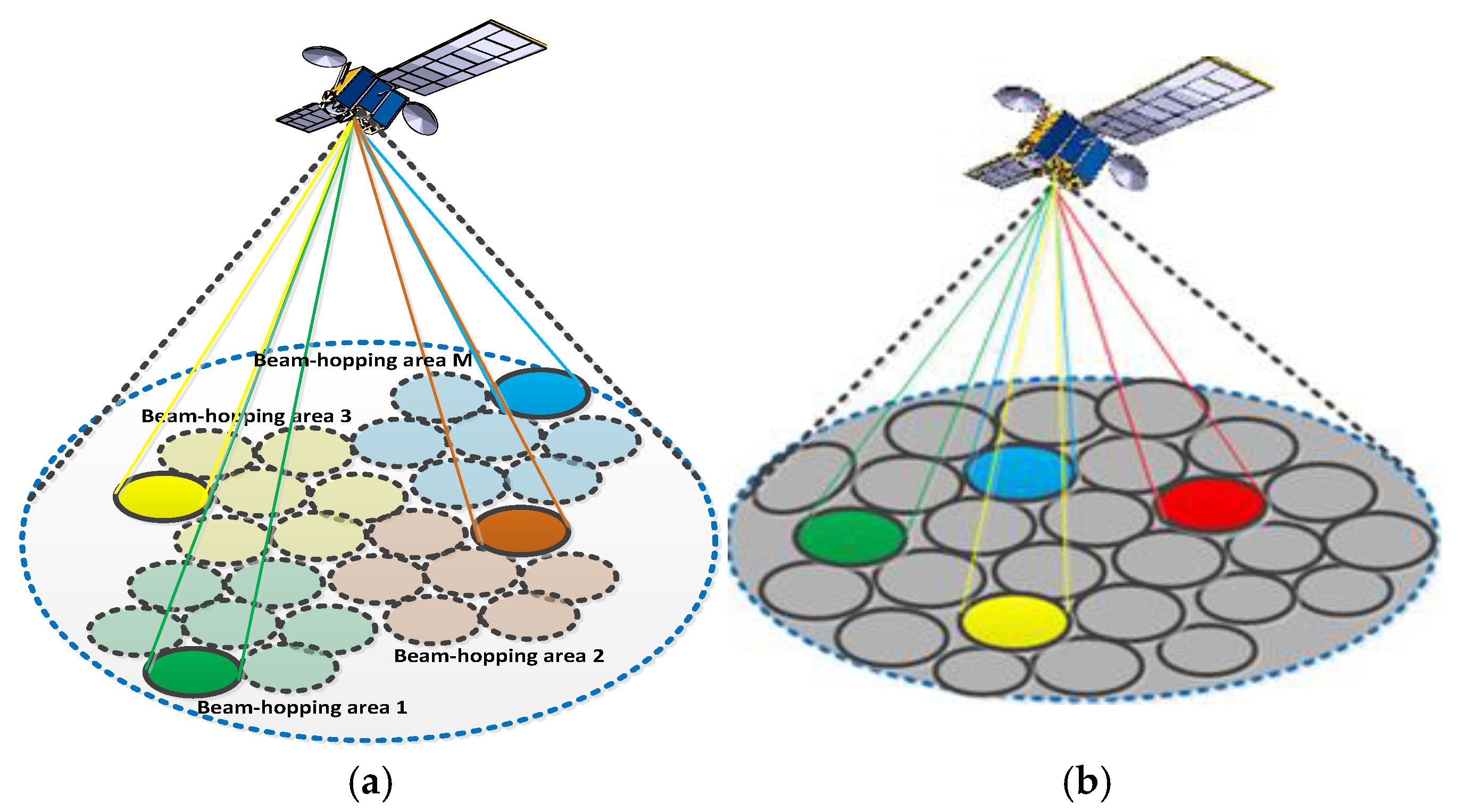


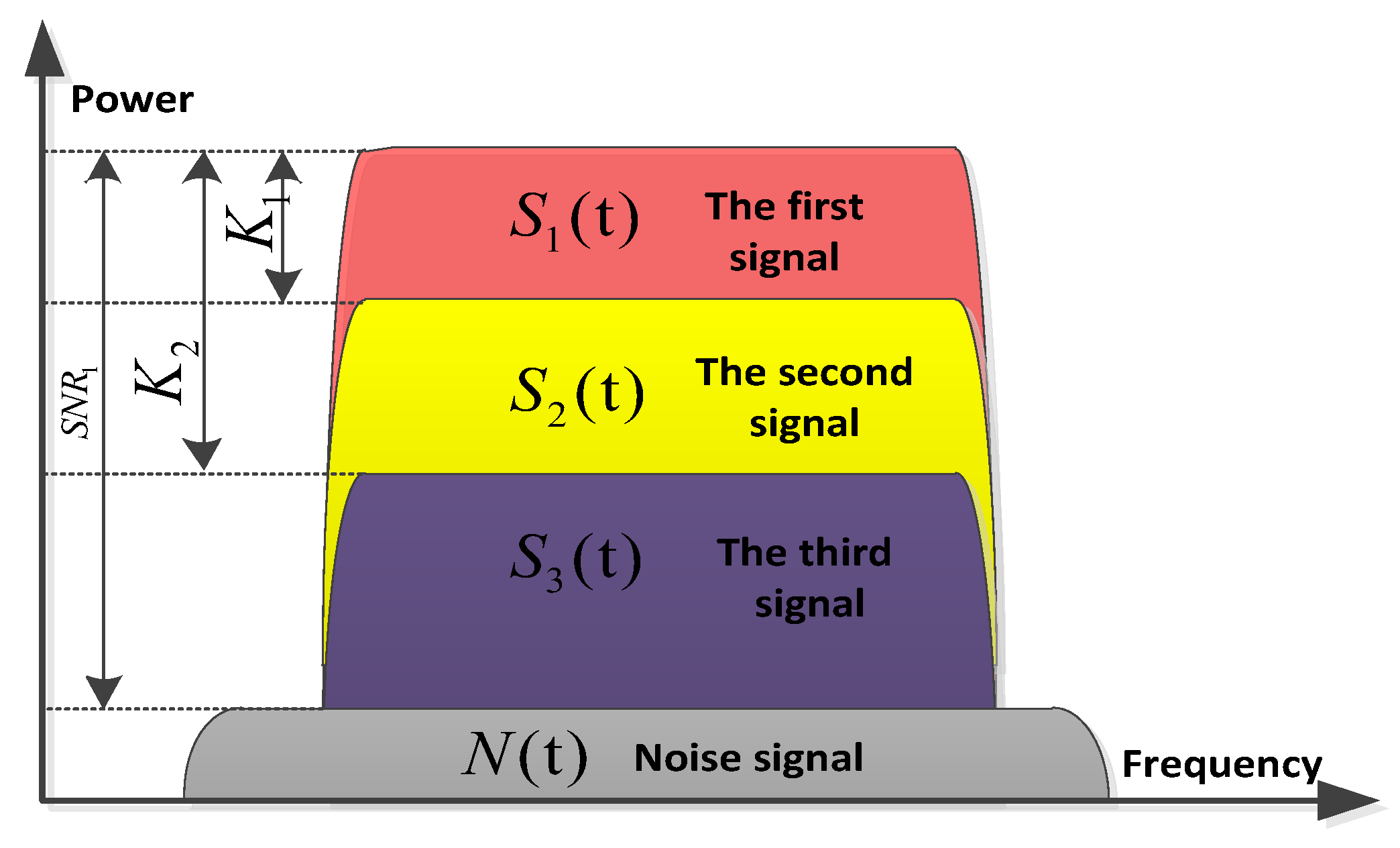
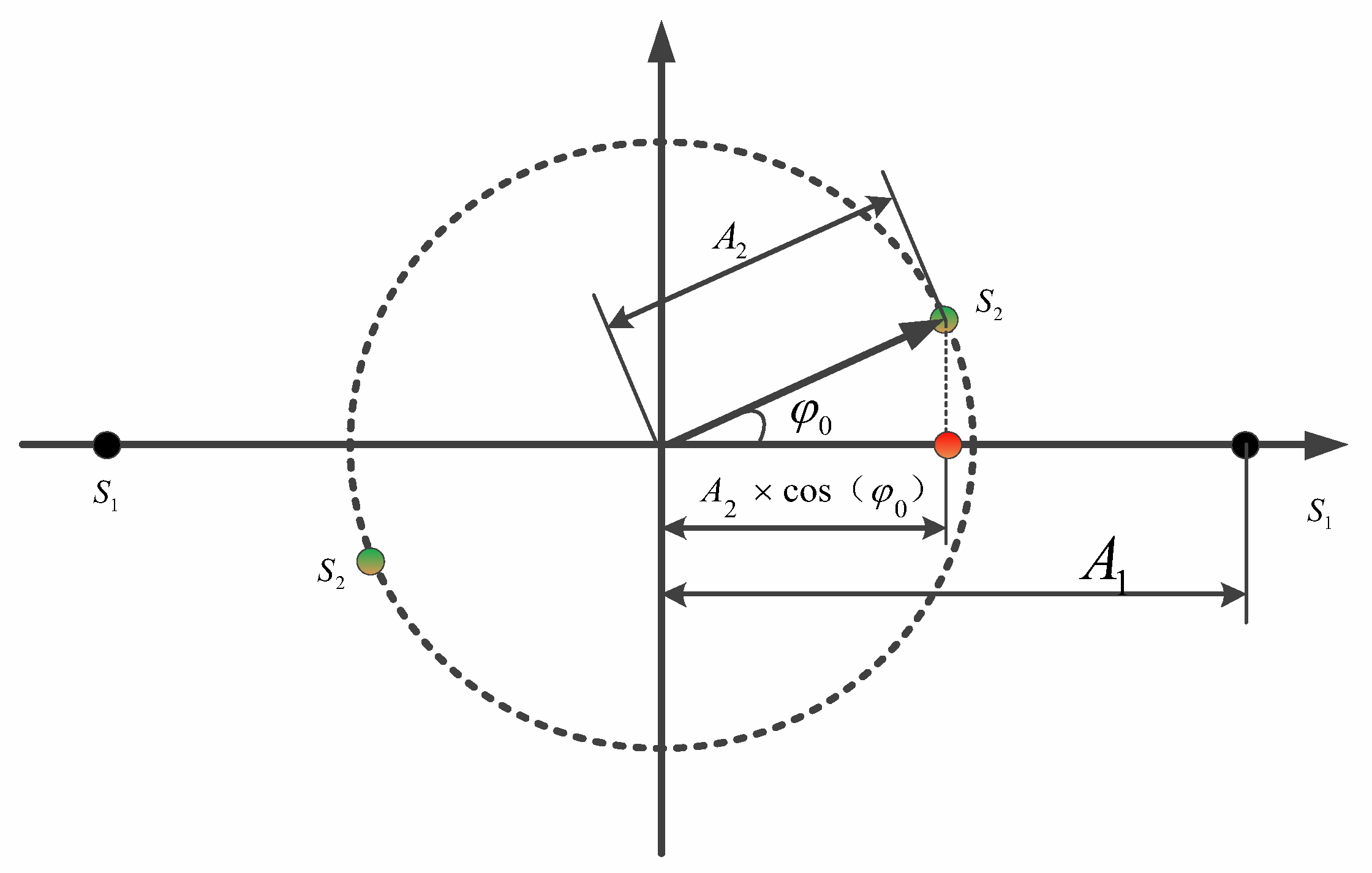
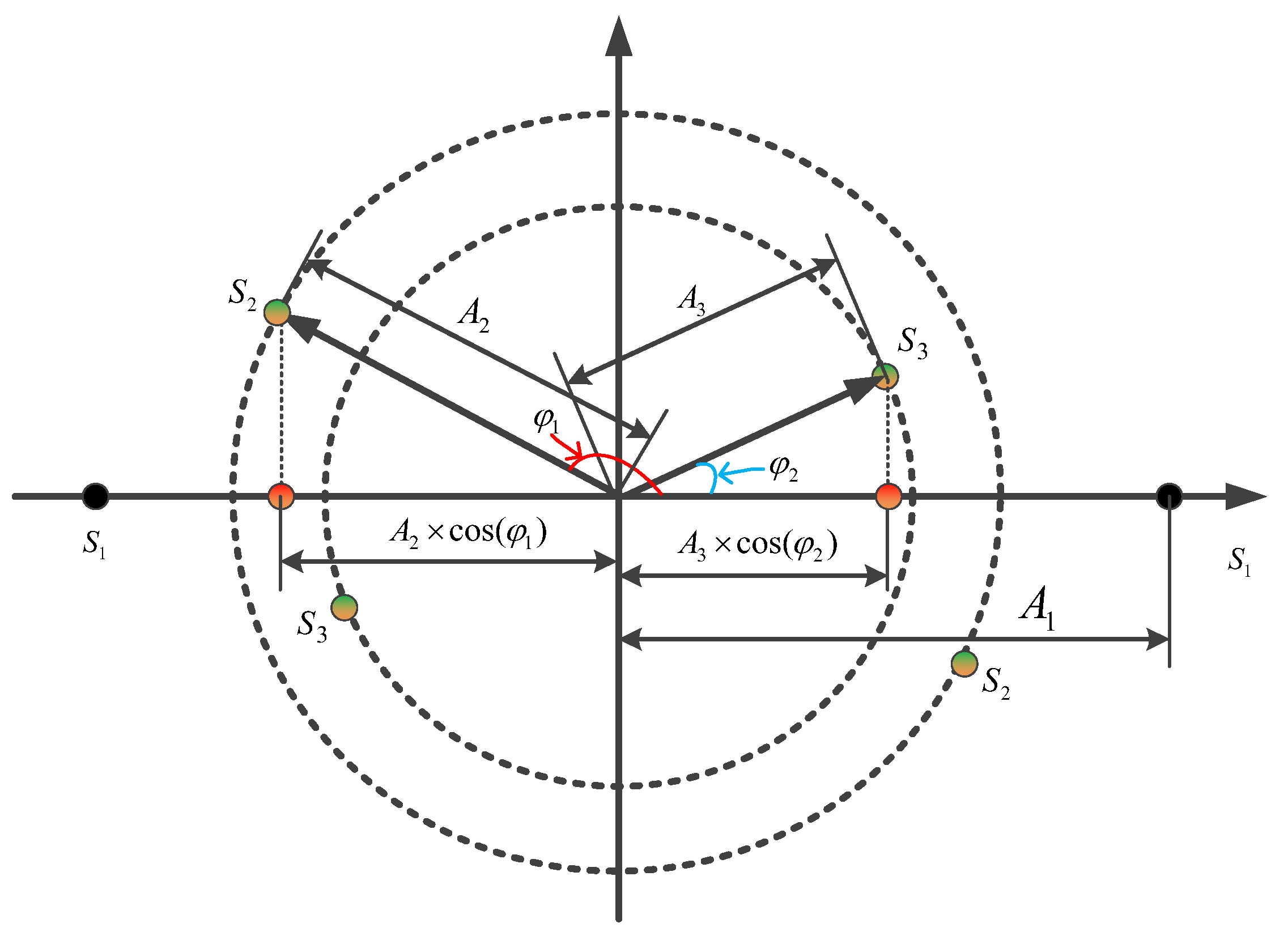

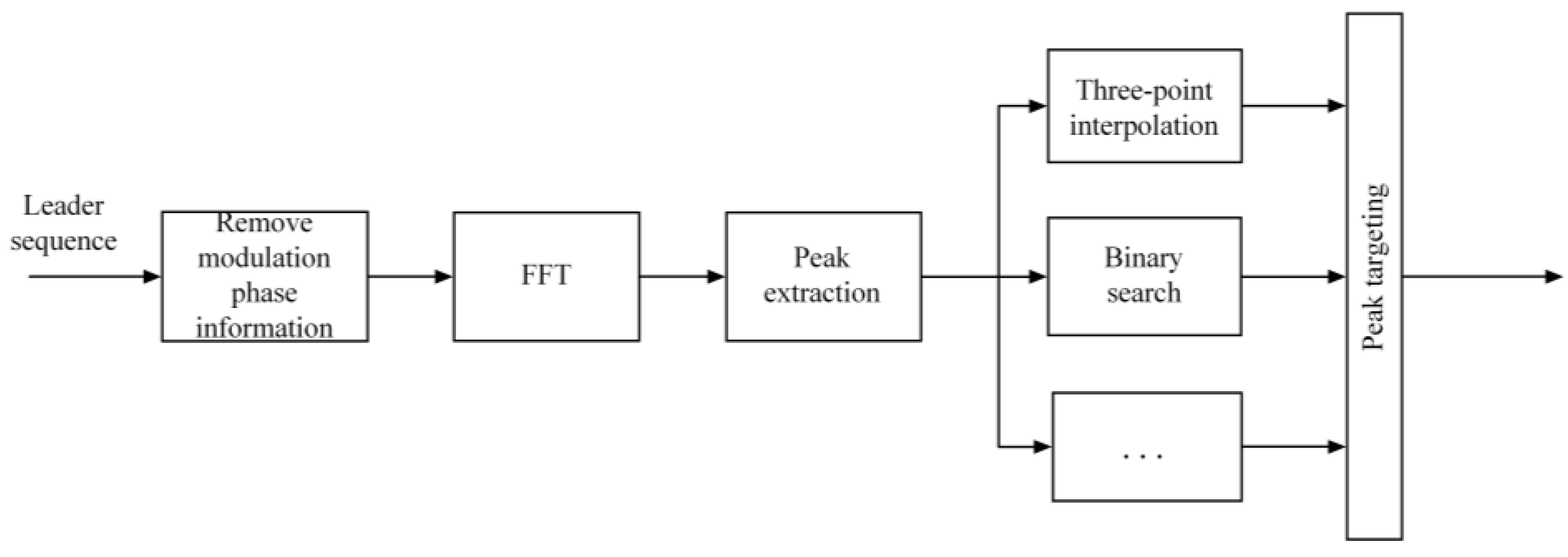

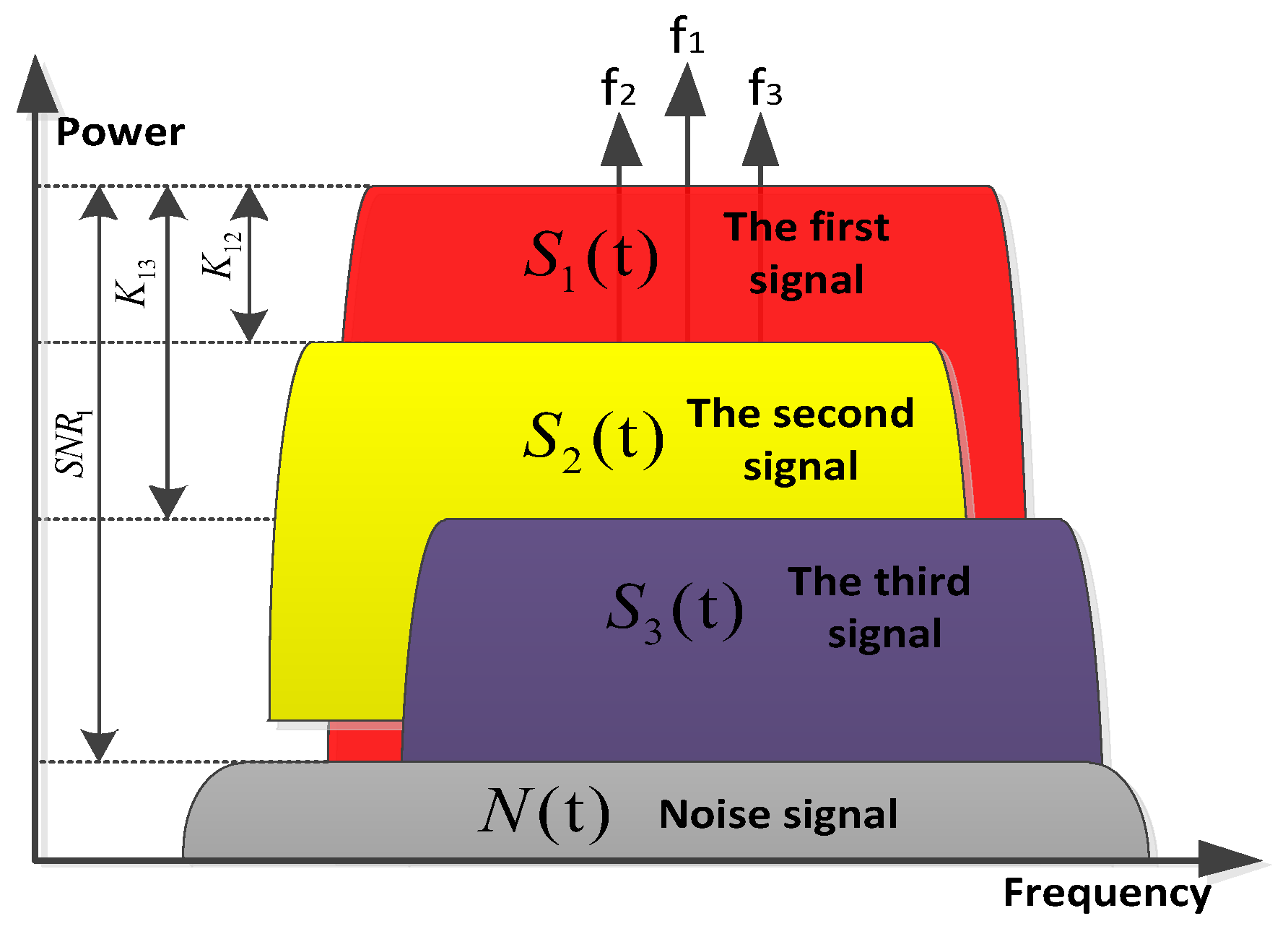
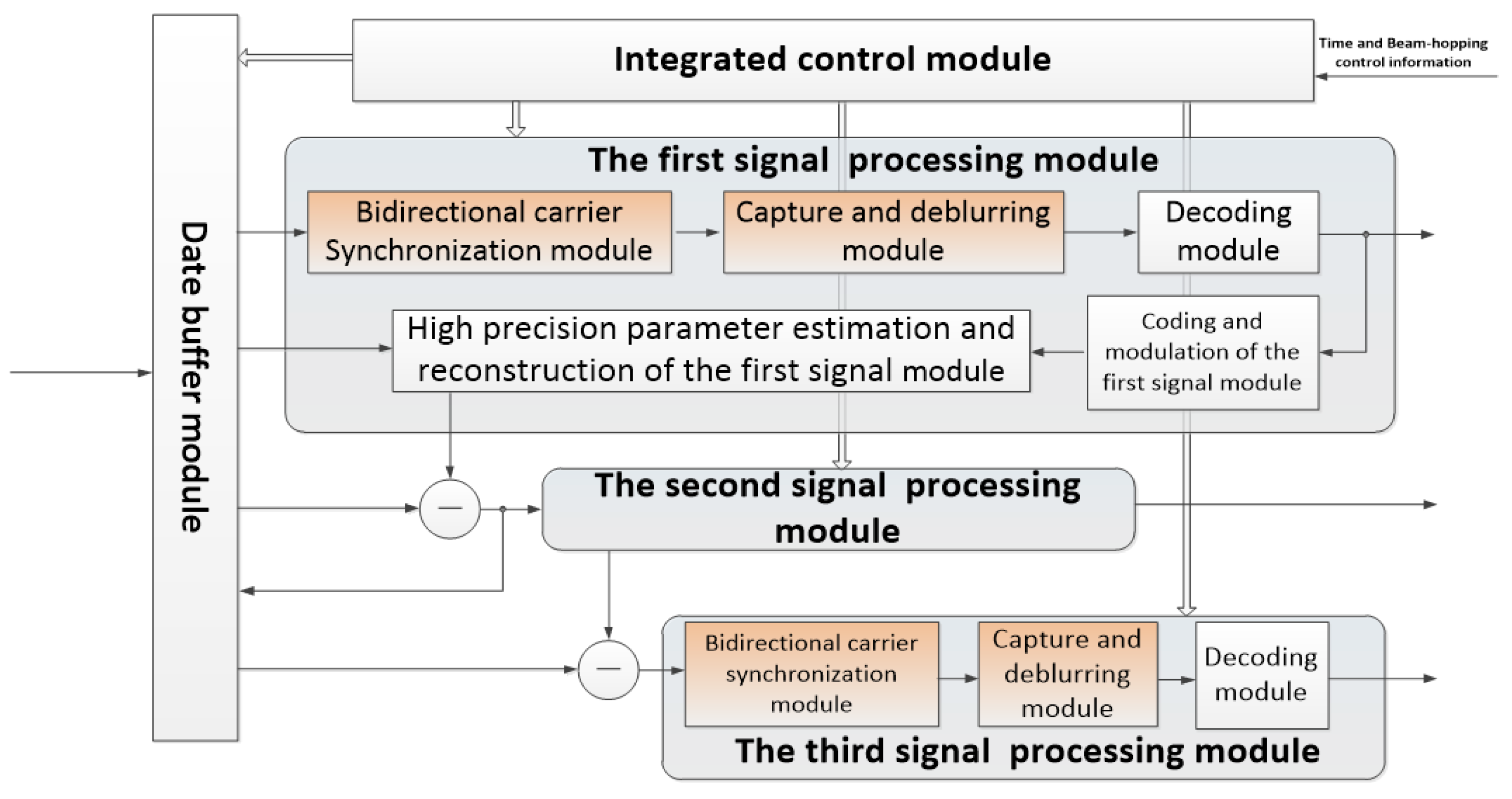

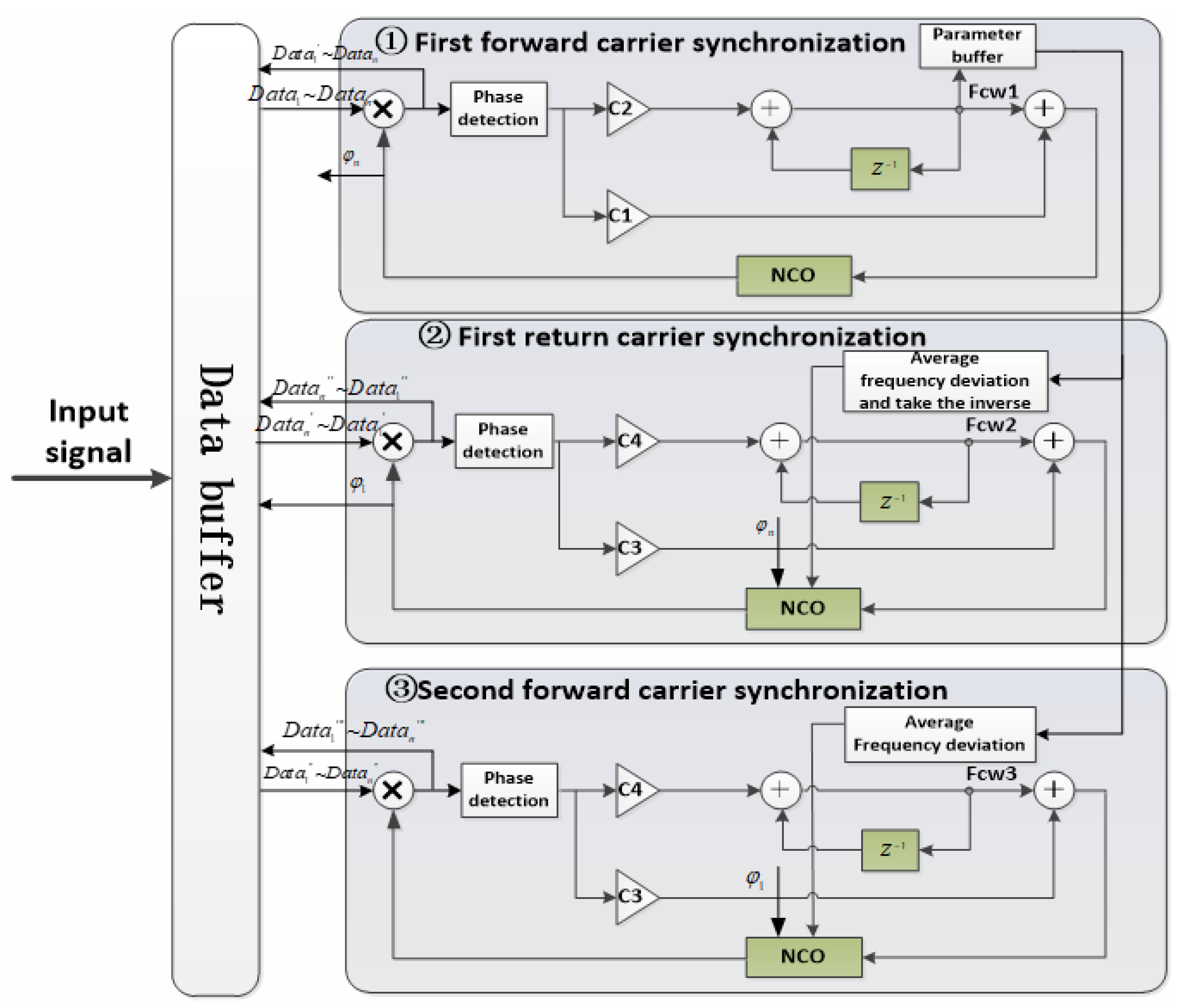


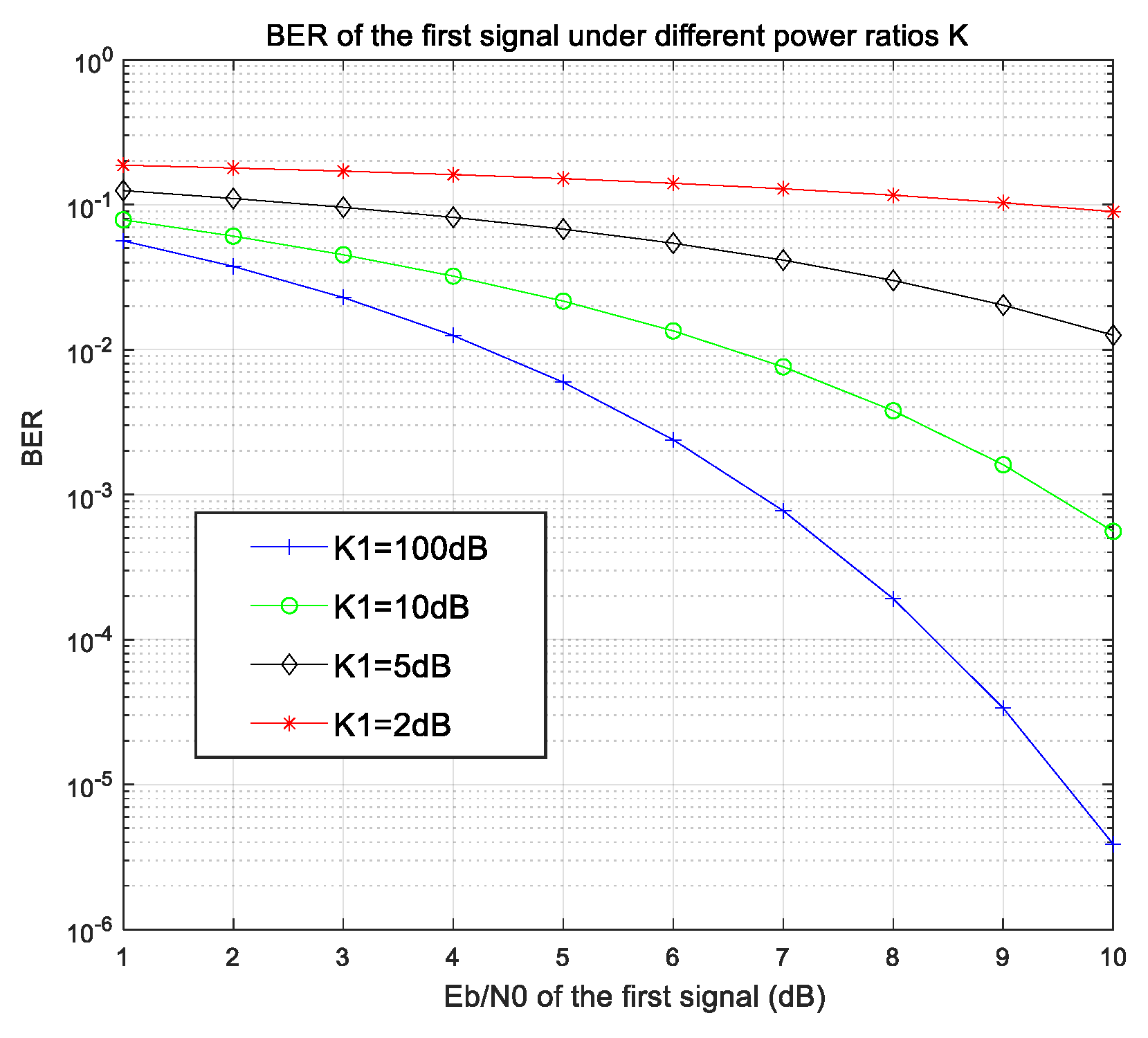
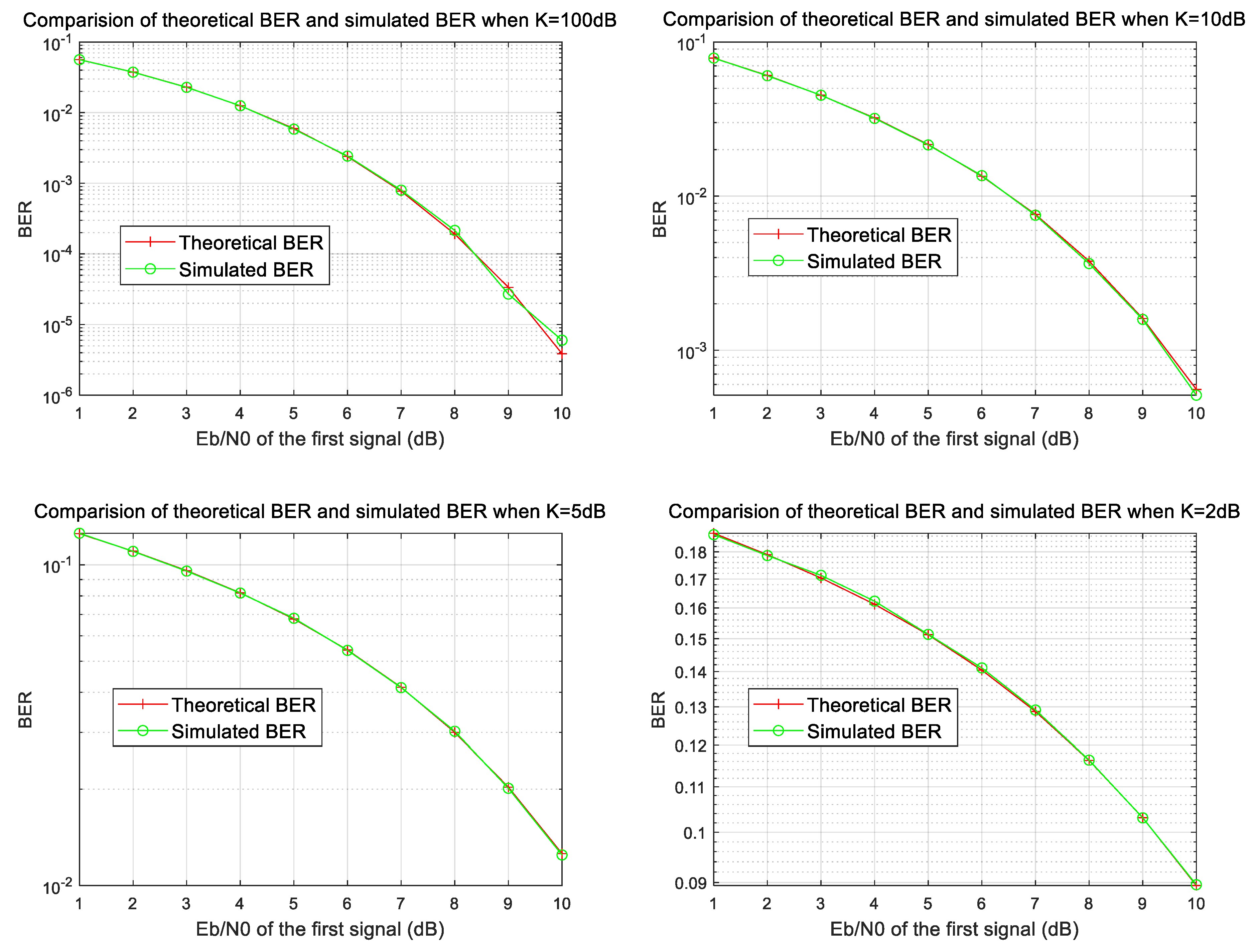

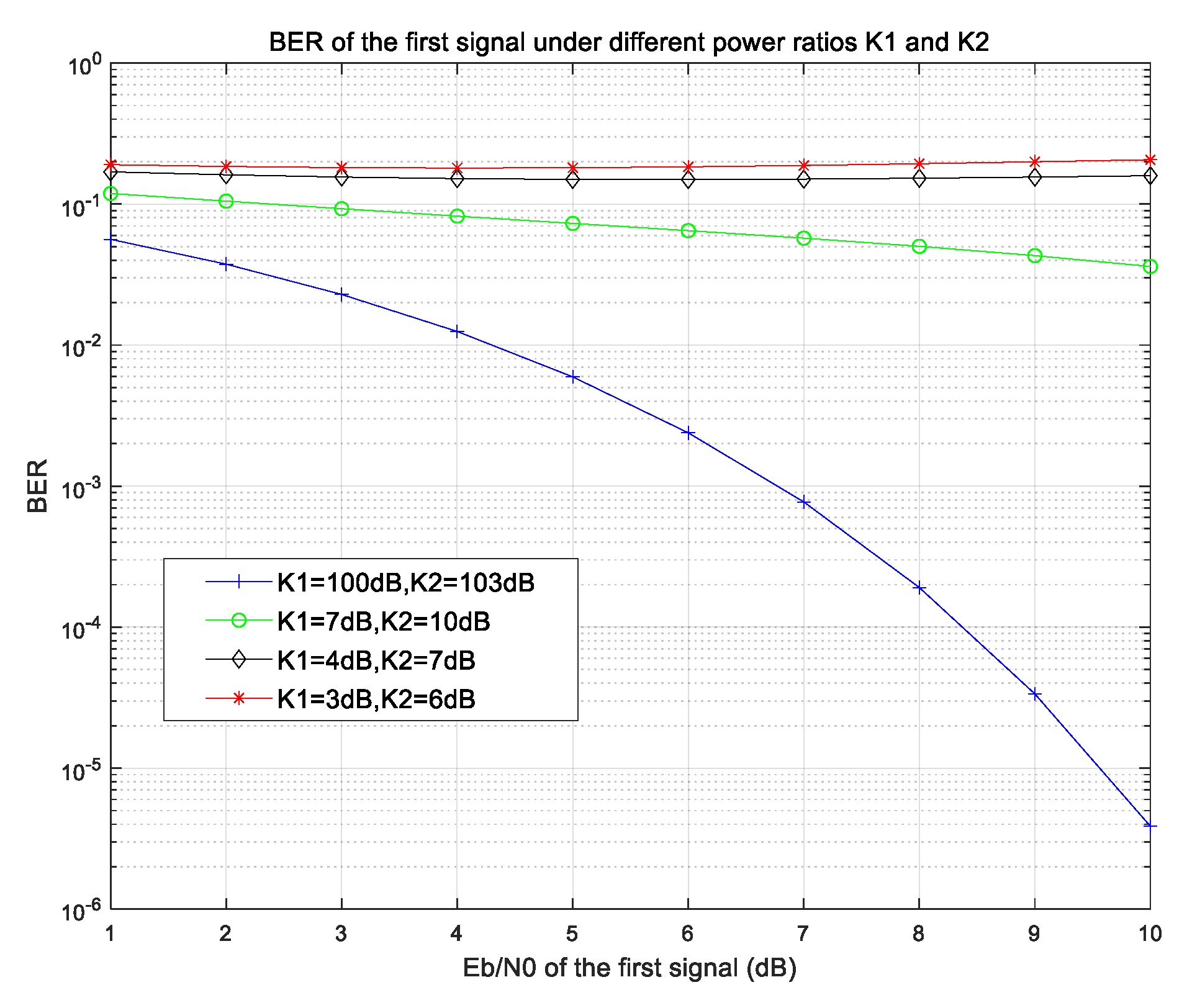
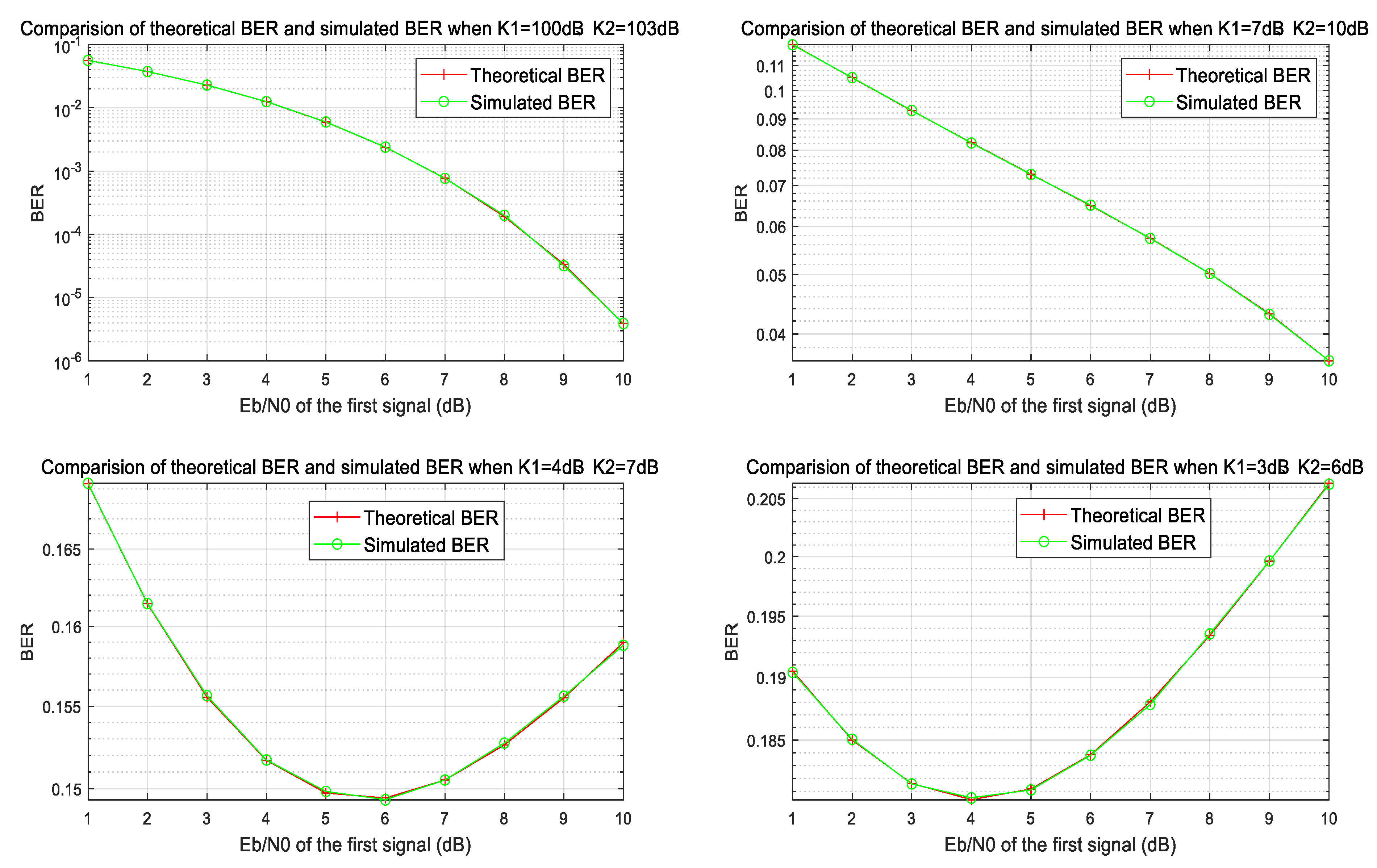
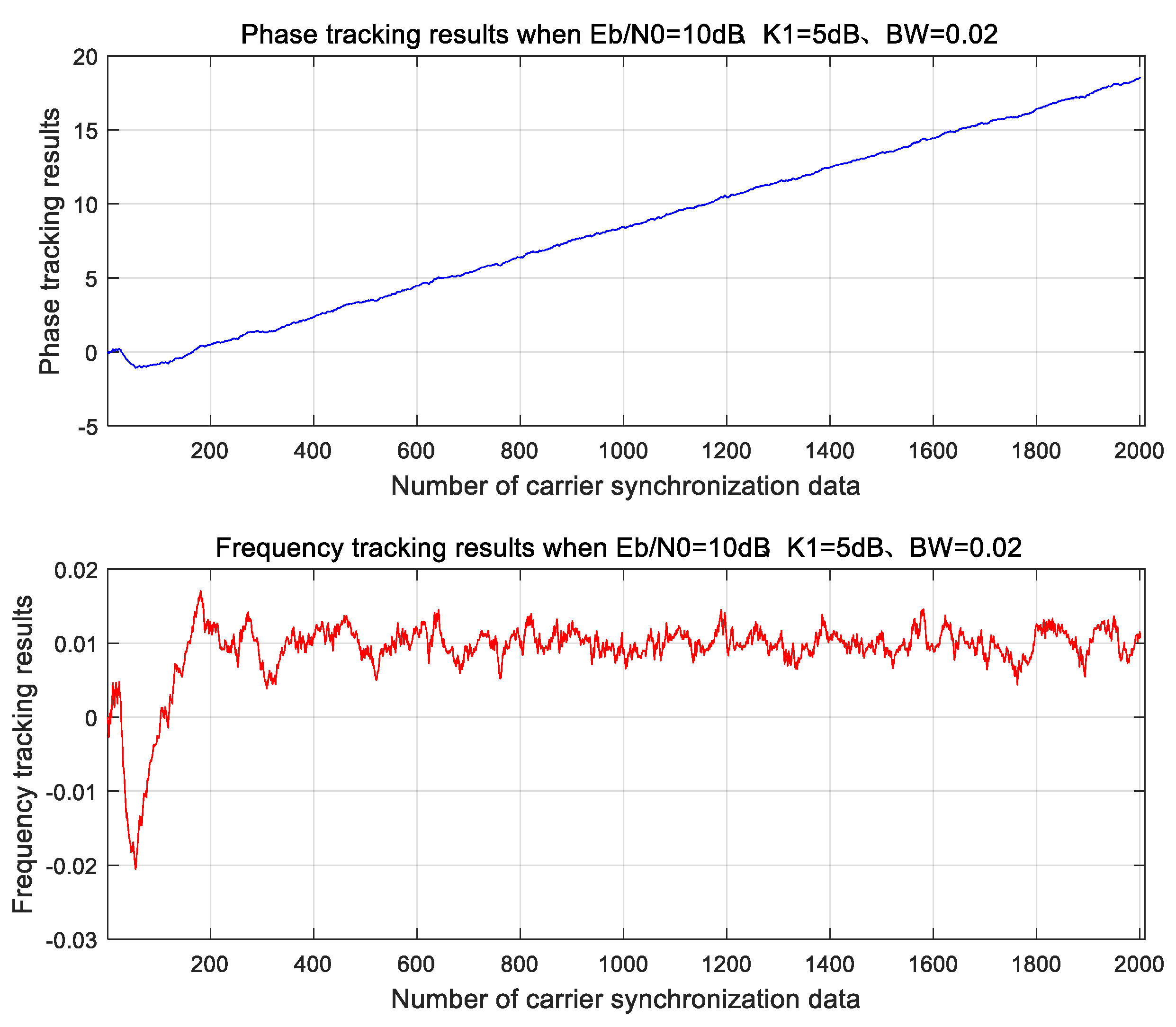
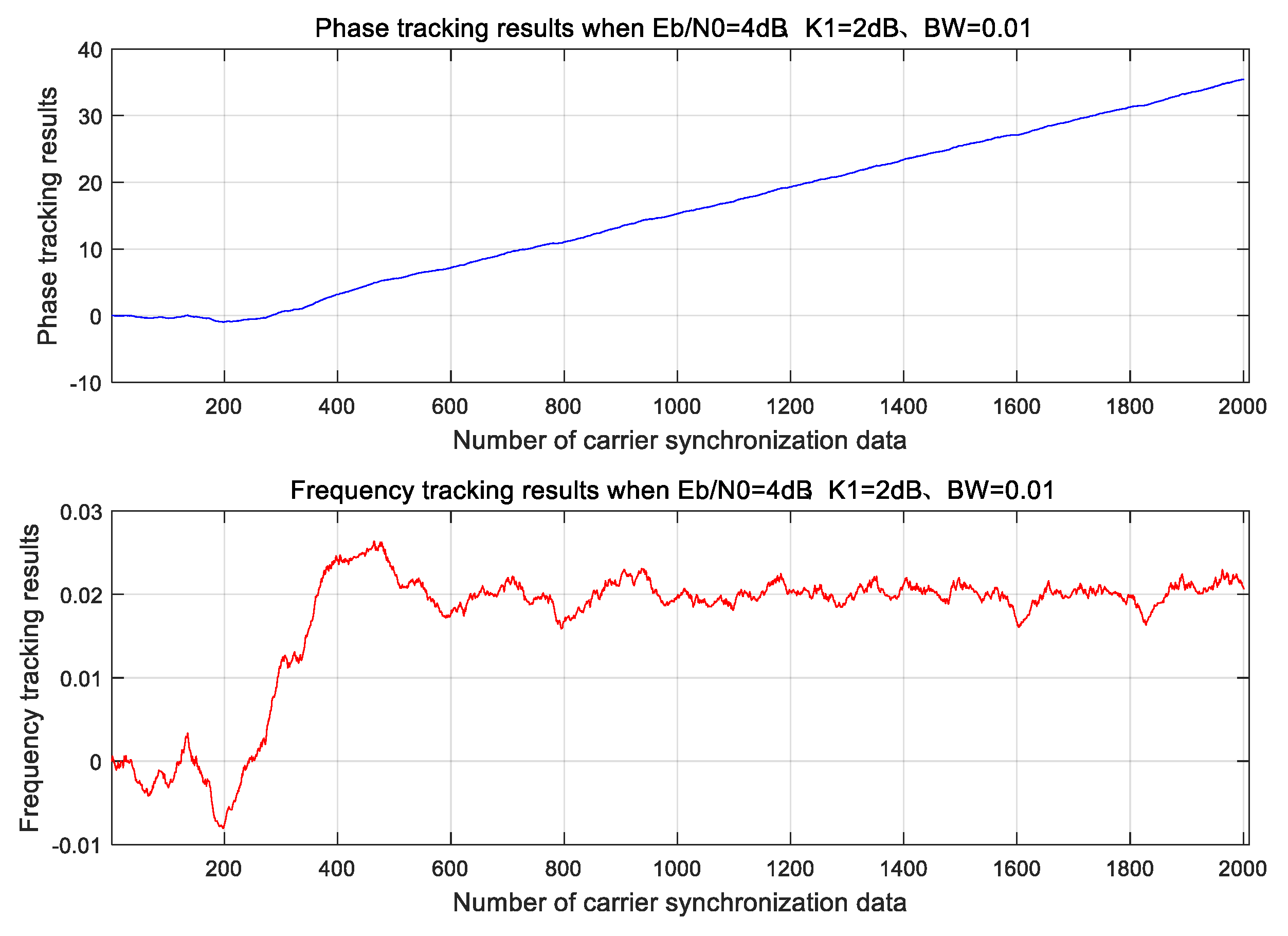


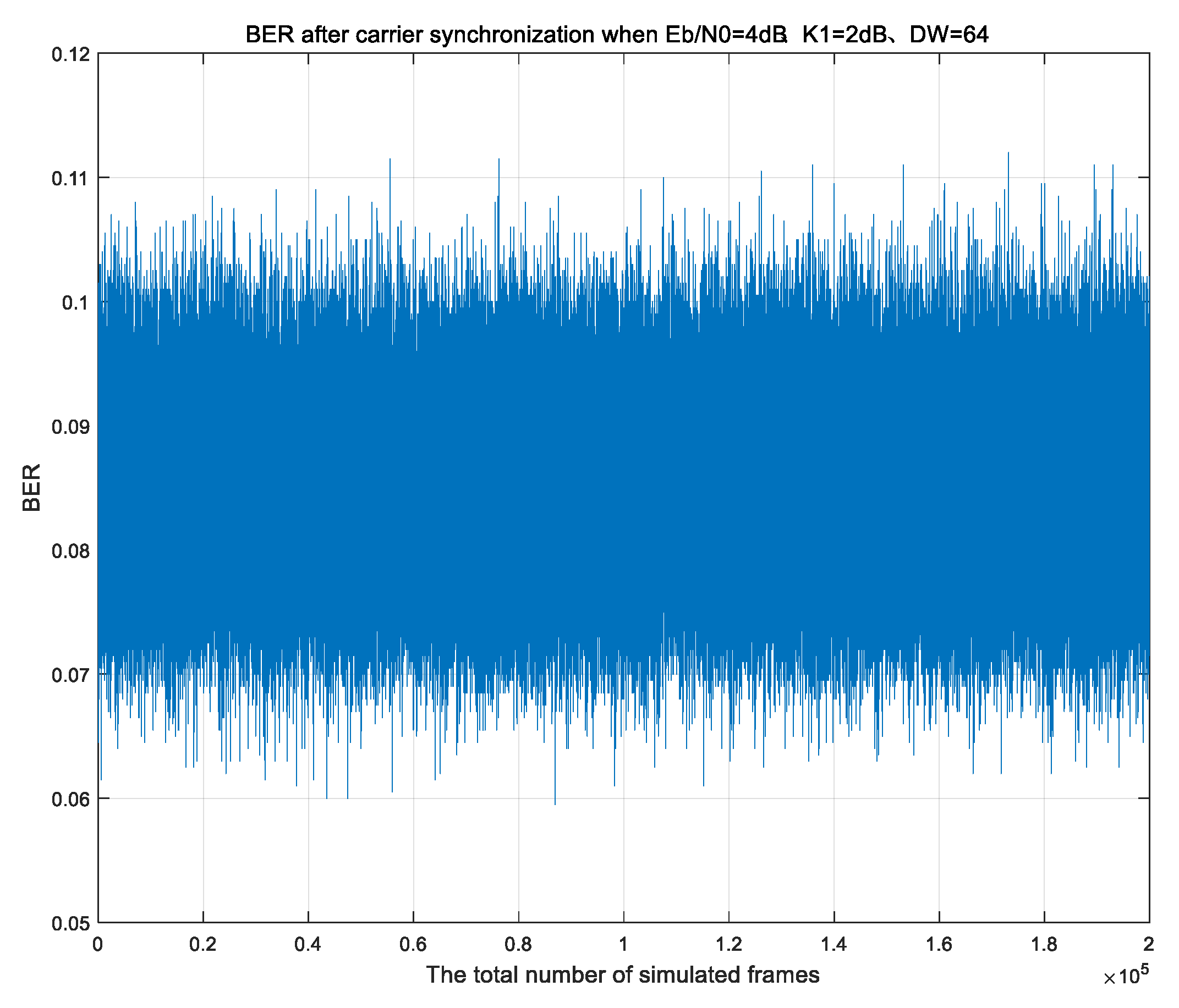
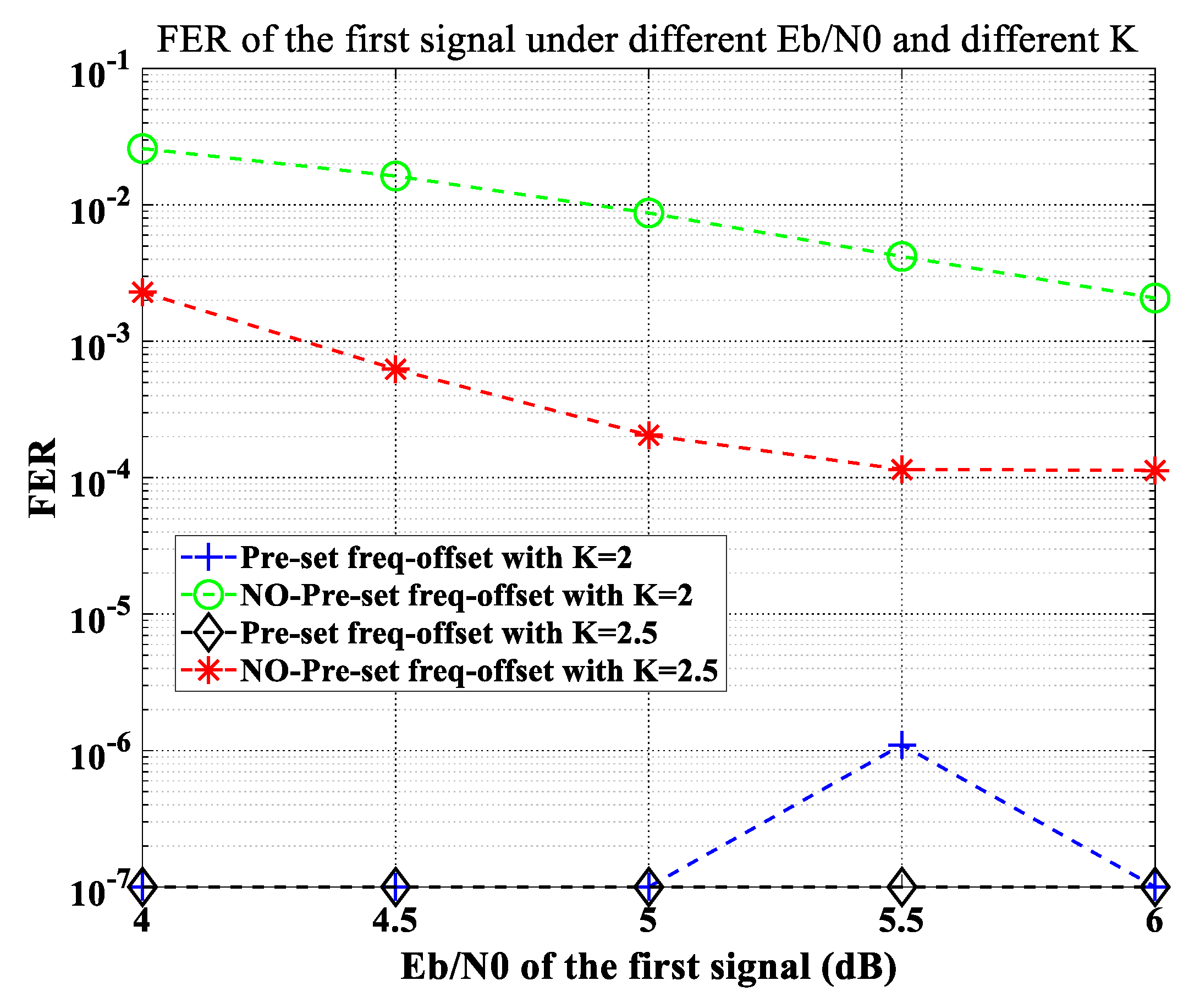
| Feature | MF-TDMA | NOMA-SIC |
| Spectral Efficiency | Lower. Resources (time and frequency slots) are orthogonal, underutilization. | Higher. Superimposes multiple users on the same time-frequency resource, serving more users simultaneously and improving overall cell throughput. |
| Latency | Predictable and Fixed. | Variable and Complex. |
| Complexity | Low (Transmitter)/Moderate (Receiver). Simple transmission; complexity is centralized in the gateway/scheduler for resource allocation. | High (Transmitter)/Very High (Receiver). Requires sophisticated power allocation algorithms at the transmitter and complex SIC decoding at the receiver. |
| Index | Monte Carlo Trials (N) | Variance | Standard Deviation |
|---|---|---|---|
| 1 | 1024 | 0.0350 | 0.0011 |
| 2 | 128 | 0.0348 | 0.0031 |
| 3 | 32 | 0.0360 | 0.0064 |
| Simulation Parameter | Value/Setting |
|---|---|
| Symbol rate | 5 Msps |
| Maximum initial frequency offset | 50 kHz (relative offset = 0.01) |
| SNR of the first signal | 4 dB |
| Power ratio between first and second signal | 2 dB |
| Modulation | BPSK |
| Data length | 2000 symbols |
Disclaimer/Publisher’s Note: The statements, opinions and data contained in all publications are solely those of the individual author(s) and contributor(s) and not of MDPI and/or the editor(s). MDPI and/or the editor(s) disclaim responsibility for any injury to people or property resulting from any ideas, methods, instructions or products referred to in the content. |
© 2025 by the authors. Licensee MDPI, Basel, Switzerland. This article is an open access article distributed under the terms and conditions of the Creative Commons Attribution (CC BY) license (https://creativecommons.org/licenses/by/4.0/).
Share and Cite
Hui, T.; Zhai, S.; Hui, M.; Gong, F.; Lin, R.; Fu, Y. Enhancing Multiple-Access Capacity and Synchronization in Satellite Beam Hopping with NOMA-SIC. Electronics 2025, 14, 3578. https://doi.org/10.3390/electronics14183578
Hui T, Zhai S, Hui M, Gong F, Lin R, Fu Y. Enhancing Multiple-Access Capacity and Synchronization in Satellite Beam Hopping with NOMA-SIC. Electronics. 2025; 14(18):3578. https://doi.org/10.3390/electronics14183578
Chicago/Turabian StyleHui, Tengfei, Shenghua Zhai, Mingming Hui, Fengkui Gong, Ruyan Lin, and Yulong Fu. 2025. "Enhancing Multiple-Access Capacity and Synchronization in Satellite Beam Hopping with NOMA-SIC" Electronics 14, no. 18: 3578. https://doi.org/10.3390/electronics14183578
APA StyleHui, T., Zhai, S., Hui, M., Gong, F., Lin, R., & Fu, Y. (2025). Enhancing Multiple-Access Capacity and Synchronization in Satellite Beam Hopping with NOMA-SIC. Electronics, 14(18), 3578. https://doi.org/10.3390/electronics14183578







